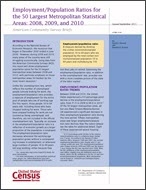Employment/Population Ratios for the 50 Largest Metropolitan Statistical Areas: 2008, 2009, and 2010
Employment/Population Ratios for the 50 Largest Metropolitan Statistical Areas: 2008, 2009, and 2010
Introduction
According to the National Bureau of Economic Research, the recession that began in December 2007 ended in June 2009.1 However, during 2009 and 2010, many areas of the country were still struggling economically. Using data from the American Community Surveys (ACS), this report will show employment/population ratios for the 50 largest metropolitan areas between 2008 and 2010, with particular emphasis on those metropolitan areas hit hardest by the most recent recession.2
Unlike the unemployment rate, which reflects the number of unemployed people actively looking for work, the employment/population ratio provides a measure of employment for the entire pool of people who are of working age (for this report, those people 16 to 64 years old), including those who have stopped looking for work. Those who have stopped looking for work are not counted as being unemployed, and therefore, are not included in the official unemployment rate. Typically, an increase in the employment/population ratio is a reflection of economic growth as a larger proportion of the population is employed. The employment/population ratio decreases whenever the working-age population grows without a corresponding increase in employment, or whenever large numbers of people 16 to 64 years old stop working, either because they lost their jobs or retired. Examining the employment/population ratio, in addition to the unemployment rate, provides one with a more complete picture of the state of the labor market.
__________
1 See <www.nber.org/cycles/sept2010.html> for more information.
2 For more information on metropolitan statistical areas, please see <www.whitehouse.gov/sites/default/files/omb/assets/bulletins/b10-02.pdf>.
Others in Series
Publication
Publication
Publication




